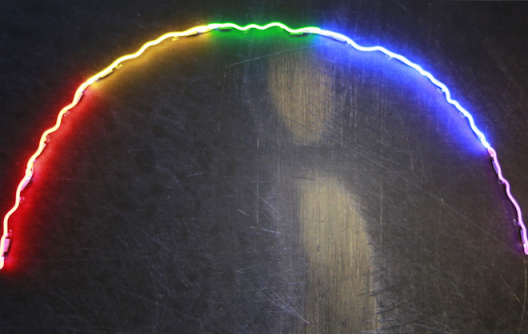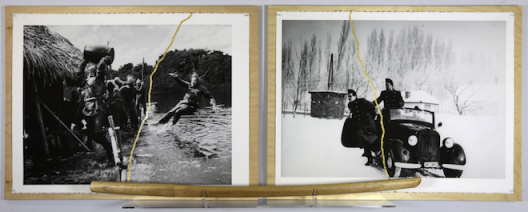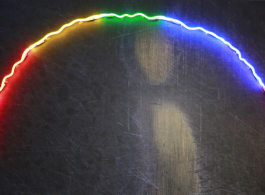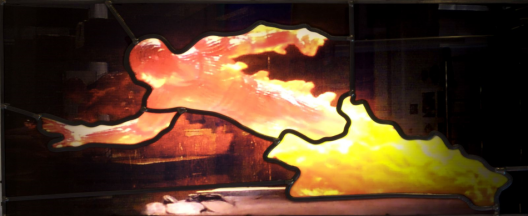Galerie Nathalie Obadia in Brussels is delighted to present the solo exhibition by Sarkis, more than twenty years after his last exhibition in Belgium.* The event is all the more eagerly expected as 2015 was a very busy and productive year for Sarkis.
In May 2015, at the 56th Venice Biennale, under the curatorship of Defne Ayas, director of Witte de With (Rotterdam, Netherlands), Sarkis created an installation titled Respiro for the Turkish Pavilion. Also at the Venice Biennale, this time under the curatorship of Adelina Cüberyan von Fürstenberg, he was included in the exhibition Armenity, which brought together the most talented artists from the Armenian diaspora in the Pavilion of the Armenian Republic. The Pavilion was the winner of the Golden Lion this year.
In September 2015, Sarkis was also invited to take part in the 14th Istanbul Biennial, whose curator, Carolyn Christov-Bakargiev, had directed the last Documenta in 2012.**
In September 2015, the Villa Empain – Fondation Boghossian in Brussels devoted an exhibition to two major artists of contemporary Armenian culture: Sarkis, who was born in Istanbul in 1938, and the filmmaker Sergueï Paradjanov (1924–1990). In Sarkis with Paradjanov,*** Sarkis’s work was invited to dialogue with that of the dissident Georgian filmmaker. Not limiting itself to underlining the points in common between two creative universes, the show revealed the importance that cinema plays in the use of images in Sarkis’s art.
The exhibition at the Galerie Nathalie Obadia, titled Il Grido (Italian for ‘the cry’ or ‘the scream’) by Sarkis in tribute to the film of the same name by Michelangelo Antonioni, also reflects this creative love of cinema, which is here combined other sources of inspiration, most importantly the famous Screamby Edvard Munch (1863–1944). This iconic painting of 20th-century modern art is the common thread in this exhibition of some thirty mixed-media works, passing from painting to stained glass to a sound and light installation.
Sarkis “began art with The Scream”, he says. He first became aware of Munch’s painting during his adolescent years. As the young Sarkis tore out magazine pages to wrap fresh meat with his father, a butcher, he came across a reproduction of the Scream. It was a shock for this young lad from Istanbul who had never seen a painting. The image stuck in his mind and he decided to become an artist.
Six decades later, the exhibition at the Galerie Nathalie Obadia in Brussels manifests the acknowledgement of this Armenian artist to the Norwegian painter’s masterpiece and reveals all the power and importance of images – such as icons – in Sarkis’s creative universe.
Galerie Nathalie Obadia Brussels is presenting the Vitraux des Innocents (2007) for the first time. These ten stained-glass works are particularly important for Sarkis as they were the first of his “stained-glass easel works”, small compositions made from stained glass that render the technique independent of architecture for the first time.
It should be remembered that with regard to stained-glass works in France, Sarkis’s adopted country since 1964, the artist has created major series for Silvacane Abbey (2001) and the Priory of Saint-Jean-du-Grais (2004). These creations, praised by art critics, have established Sarkis as one of the leading artists to work with stained glass in the 21st century.
Light, which lies at the heart of Sarkis’s work, is here perceived in the form of backlit windows aligned in a corridor whose darkness helps to bring out their intense reddish glow. The preparatory designs created on the glass in lead-tin alloy are presented on the external sides to draw attention to the structure of which the compositions are made.

Sarkis, Le cri sous son arc-en-ciel, 2015. Photograph (Ali Kazma) on aluminium with color neons, 140 x 220 cm.
The exhibition also includes a new series of Kintsugi. By adapting this 15th-century Japanese practice of repairing broken ceramics to paper, Sarkis has made this technique his own.
A thin line of gold powder makes it possible to trace the tears that scar images taken, for the most part, from black-and-white films by Federico Fellini, Andrei Tarkovsky and Otto Preminger, and from works by the Russian photographer Dmitri Baltermants.
Sarkis combines these stills with objects from very different cultures and origins, all of which were found by chance or hunted down during his research or wanderings.
Once assembled by the artist, the photograph scarred with gold leaf and the chosen object form a single entity. Reunited, they halt time and make perceptible the fissures of history caused by armed conflict, like Kintsugi with ‘Aguirre’ (Werner Herzog) and ‘Jours glacés’ (András Kovács) + Bokken Kendo, in which two equally tragic moments from distinct historical epochs are brought together.
The gold kintsugi line symbolizes repair. It acts as a balm. In this sense Sarkis is a repairer. His art reconciles, welds, patches, strengthens and alleviates wounds of the senses and memory.
This was why he was chosen to present works in both the Turkish and Armenian pavilions at the 2015 Venice Biennale, a selection that was both a powerful symbol and responsibility for this artist of Armenian culture born in Turkey.

Sarkis, Kintusgi avec Aguirre (Werner Herzog) et Jours Glacés (Andras Kovacs) + Bokken Kendo, 2015. Inkjet print on Arches paper 300gr, gold upon Kintsugi method, bokken kendo, 63 x 168 cm.
For the Turkish pavilion, Sarkis produced a work titled Respiro, from which the light installation Le cri sous son arc-ciel exhibited at the Galerie Nathalie Obadia Brussels borrows the colour code and waves of curved neon tubes.
Like an electric arc, the coloured band from the work cuts through an image taken from a video by Ali Kazma (a Turkish video director born in Istanbul in 1971). It forms a sine wave as though representing a sound frequency, in this case that of the most famous scream in the history of art.
Munch painted the first version of his Scream in 1893 to portray the torment being suffered during the birth of the modern world, which was then undergoing rapid change. Using his own materials, Sarkis gives a similar message that he cries out to his contemporaries. ‘Unite’ is one of the watchwords whose urgent necessity is continuously hammered home by events. His own cry, whatever plastic form he makes use of, is contained in a “sound-silence”,**** a typical characteristic of his art, which is more poetic than expressionist.
Other works offer the same dramatic melody throughout the exhibition Il Grido, for example, Cri Emerald Green, Cri-Pink and Cri Lamp Black offer glowing variations of Munch’s Scream with different thicknesses of colour.
Two graphic works also have a formal relation with the Norwegian artist’s painting: D’après masque Lega Zaïre and D’après le masque Benin. In both cases the almond-shaped colour is not unlike the face in the Scream frozen like a mask of terror. This reference to African masks is also an allusion to the debt owed to tribal arts by the European avant-gardes at the start of the 20th century.
The works also show Sarkis’s interest in the use of taches in his art. Linseed oil in the paint is absorbed by the paper, creating rings of colour around such motifs as faces, masks and crosses. This phenomenon, by its very nature of uncertain outcome, has a manifest poetic power.
The same poetry is apparent in Sarkis’s letters written during summer 2015 in Istanbul as he prepared for the Istanbul Biennial, while also recovering from the emotional rush he had received at his success in Venice.
These letters, on which Sarkis stuck stamps linked with paintings by Edvard Munch and Matthias Grünewald, are dotted with black touches made using a brush and Indian ink. Side by side, they form an abstract script conceived by Sarkis to keep the content of his mysterious letters secret (2015.07.11 1ère lettre, timbre Munch; 2015.07.12 6ème lettre, timbre Grünewald Retable d’Isenheim; 2015.08.17 à Beuys, carte postale avec timbre Munch).
His dotted words seem to run along a musical stave. In these letters, the dimension of sound takes a different form from that in Respiro and Le cri sous son l’arc-en-ciel, even though they have in common a small and personal music that Sarkis hears as a “murmur”. It is up to us to listen carefully enough to catch the deeply humanist message with which the artist imbues his works, like a “smuggler” of images and emotions whose permeability in today’s multicultural world was celebrated in 2010 in the landmark exhibition Sarkis, Passages at the Centre Pompidou.
Born in 1939 in Istanbul, Turkey. Sarkis lives and works in Paris.
A graduate from the Mimar Sinan University of Fine Arts in Istanbul, Sarkis exhibited for the first time in the Istanbul Art Gallery in 1960 before moving to Paris in 1964. He works with different media and, since the late 1960s, has become an icon of contemporary art, in particular for his installations. His works have been exhibited in important institutes around the world, among which the Centre Georges Pompidou (Paris, France), the Guggenheim Museum (New York, USA), the Istanbul Modern (Turkey), the Musée d’Art Moderne de la Ville de Paris (France), the Kunst-und-Ausstellungshalle in Bonn (Germany), the Louvre (Paris, France), the Bode Museum (Berlin, Germany), the Kunsthalle in Bern (Switzerland) and the Kunsthalle in Düsseldorf (Germany). He has had major exhibitions in such important events as Documentas VI and VII (Kassel, Germany), various editions of the Venice Biennale (Italy), and in Sydney (Australia), Shanghai (China), São Paulo (Brazil), Moscow (Russia) and Istanbul (Turkey).
In the exhibition “Passages” at the Centre Pompidou in Paris in 2010, the installations dialogued with works by Kasimir Malevich, André Breton and Joseph Beuys, the latter being a major source of inspiration to Sarkis. “Passages” referenced the permanent movement between the workshop and the museum, as well as the text by Walter Benjamin on the passageways of Paris. His works, which stood as the artist’s Kriegsschatz (German for war booty), were composed of objets trouvés, works of art and ethnographic works from different civilizations. In 2011 the Musée d’Art Moderne et Contemporain in Geneva (Switzerland) devoted an important retrospective to him called “Hotel Sarkis”. In 2012 Sarkis presented “Ballads” at the invitation of the Museum Boijmans van Beuningen and the Port of Rotterdam (Netherlands), then “Ailleurs, Ici” at the Domaine de Chaumont-sur-Loire (France). In that same year, Sarkis presented his work at La Triennale in Paris, “Intense Proximité” at the Palais de Tokyo, “Néon, who’s afraid of red, yellow and blue?” at the Maison rouge – Fondation Antoine de Galbert, and the “Istanbul Modern” exhibition at the Museum Boijmans van Beuningen in Rotterdam (Netherlands).
In 2013, Sarkis was included in the “When Attitudes Become Form, Bern 1969/Venice 2013″ exhibition at the Prada Foundation (Venice, Italy), as part of the 55th Venice Biennale. This was a restatement of the famous exhibition at the Kunsthalle held in 1969 in Bern (Switzerland) titled “When Attitudes Become Form: Live in Your Head”, curated by the eminent Swiss art historian and curator Harald Szeemann , to which Sarkis had contributed in 1969.
In 2014, the Musée du Château des Ducs de Wurtemberg de Montbéliard (France) mounted a solo exhibition of Sarkis’s work.
In 2015, at the 56th Venice Biennale (Italy), Sarkis was invited to represent the Turkish Pavilion while also participating in the “Armenity” exhibition in the pavilion of the Republic of Armenia, which won the Golden Lion. In September he exhibited at the 14th Istanbul Biennial (Turkey) and was also invited to exhibit with Sergueï Paradjanov at the Villa Empain – Fondation Boghossian in Brussels (Belgium).
Sarkis’s works are held in many public collections of international renown, such as the Landes Museum (Darmstadt, Germany), the Museum Boijmans van Beuningen (Rotterdam, Netherlands), the MAMCO (Geneva, Switzerland), the Church of San Lazzaro (Venice, Italy), the Istanbul Modern (Turkey), and the ZKM | Centre for Art and Media Karlsruhe (Karlsruhe, Germany). In France, he is represented at the Centre Pompidou (Paris), Musée d’Art moderne de la Ville de Paris, Musées du Château des Ducs de Wurtemberg (Montbéliard), Musée d’Art Moderne de Saint-Étienne, Musées de la Ville de Strasbourg, CAPC de Bordeaux, Musée d’Art Contemporain de Lyon, MAC/VAL (Vitry-sur-Seine), Musée des Beaux-Arts de Nantes, Lille Métropole Musée d’art moderne, d’art contemporain et d’art brut (Villeneuve d’Ascq), Château de Chaumont-sur-Loire, Institut d’Art Contemporain de Villeurbanne/Rhône-Alpes, les Fonds Régionaux d’Art Contemporain de la Loire, du Poitou-Charentes, de Bretagne, d’Alsace, d’Auvergne, de Lorraine, d’Aquitaine, de Franche-Comté, du Languedoc-Roussillon, du Nord-Pas-de-Calais, and d’Île-de-France; the Centre national des arts plastiques (Paris), and the Collection Départementale de Seine-Saint-Denis.




